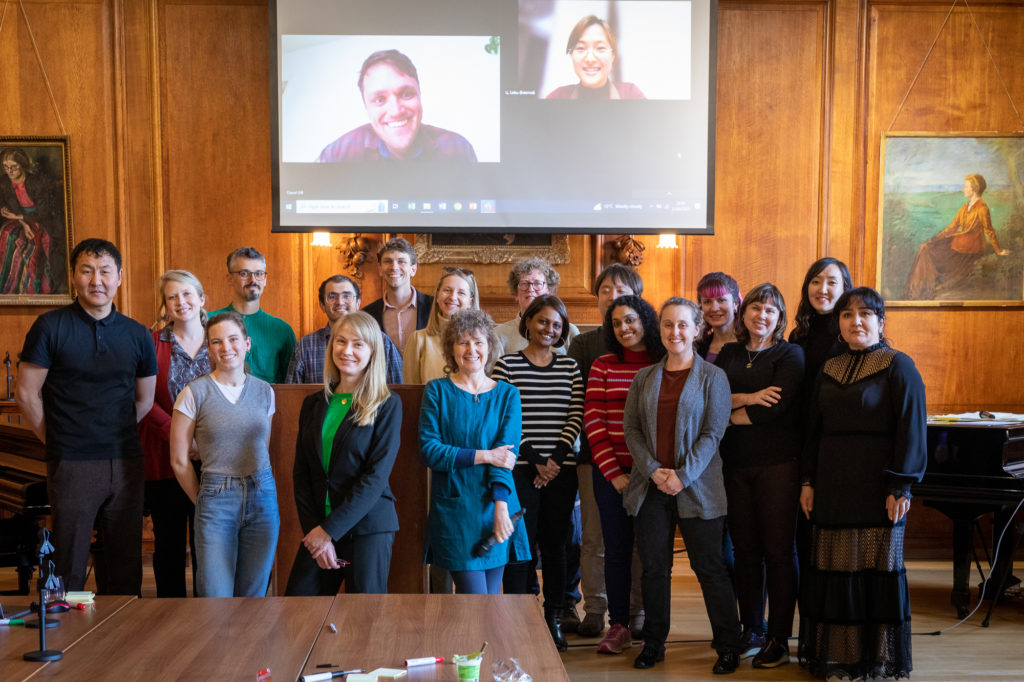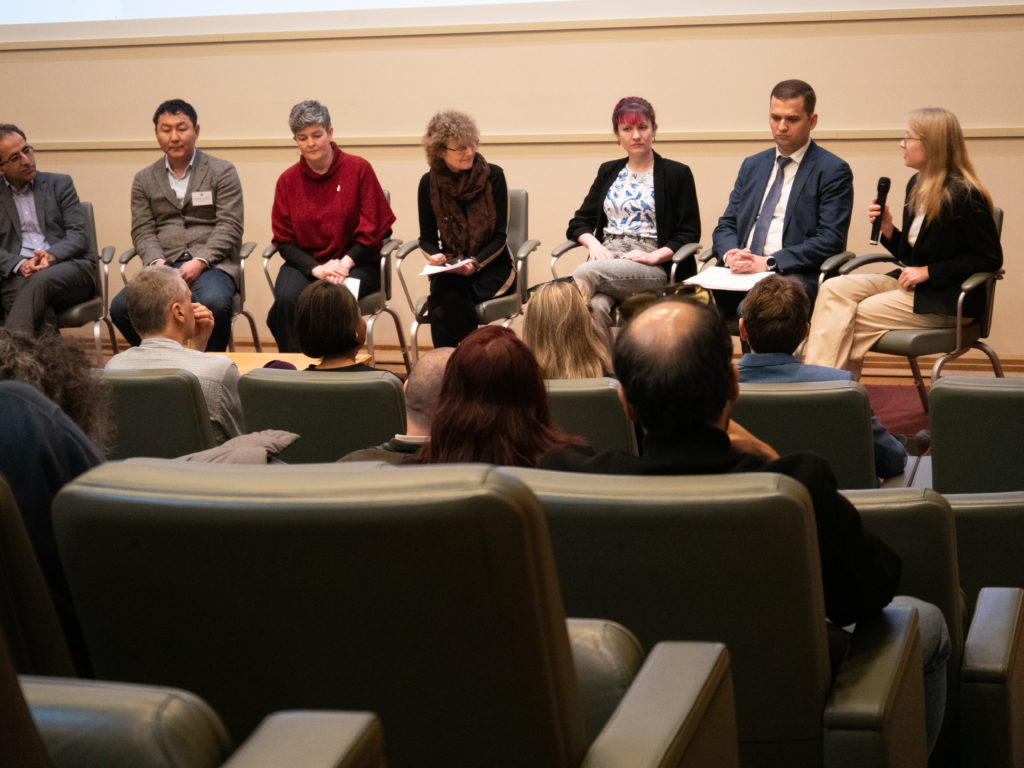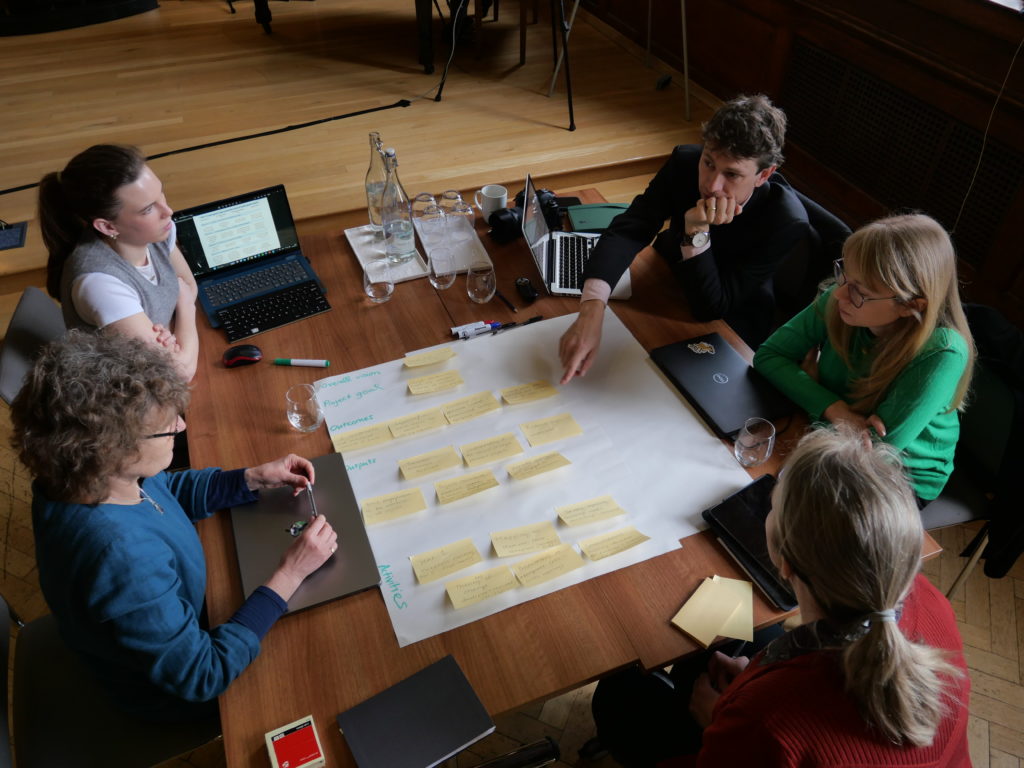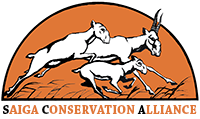In March 2023, the SCA (Saiga Conservation Alliance) hosted the ‘Saiga Inception’ meeting and ‘Conserving Wildlife in the Central Asian Steppes’ panel event in Oxford. These events brought together participants from different projects in the saiga antelope range, supported by the US Fish and Wildlife Service’s new 5-year “Catalysing Conservation Fund”. The inception meeting aimed to facilitate collaboration among projects and provide a platform for sharing objectives, approaches, and addressing key aspects such as data availability, evidence gaps, theory of change, capacity needs, and opportunities for shared learning.
With the goal of maximising collective effectiveness, the meeting was designed to be as interactive as possible, allowing participants from different projects ample time to get to know each other and explore opportunities for collaboration and support. The presence of more participants in person was seen as a measure of success for this approach.
The event brought together representatives from various organisations, including United Nation Convention for Migratory Species/Central Asian Mammals Initiative, United States Fish and Wildlife Service , Oxford University, Zoological Society of London, Wildlife Conservation Society, The Durrell Institute of Conservation and Ecology , Association for the Conservation of Biodiversity of Kazakhstan, Flora and Fauna International, Traffic, Frankfurt Zoological Society, The Royal Society for the Protection of Birds, and many more, highlighting the diverse stakeholders involved in saiga antelope conservation efforts.
In this blog, the importance of international collaboration, key players involved, and the achievements of these activities are explained in detail.

Why is international collaboration in saiga conservation so important and how can range and consumer state work together?
International collaboration is crucial for the conservation of saiga antelope, as saiga populations span across multiple countries in Central Asia, including Kazakhstan, Russia, Mongolia, Uzbekistan, Turkmenistan, where not so long ago, during winter migration, animals in search of food moved along South Ustyurt, entering from Kazakhstan. Collaborative efforts among these range states are essential for implementing conservation measures that effectively protect saiga populations and their habitats, as saigas migrate across borders and face threats from various sources, such as habitat loss, hunting, and disease.
Saiga horn consumer states, which are countries where saiga products are consumed, also play a significant role in saiga conservation. These countries, including China and several other Asian countries (Japan, Malaysia and Singapore), can work more closely with saiga range states by implementing strict regulations and enforcement measures to curb illegal trade in saiga products, particularly saiga horn, which is highly valued in traditional Chinese medicine. By reducing demand for saiga products and strengthening regulations, consumer states can help reduce poaching and illegal trade, which are major threats to saiga populations.
Saiga antelopes are a critically endangered species that face various threats, including habitat loss, poaching for their horns, and illegal trade. Therefore, effective conservation efforts require coordinated action at the international level to address these challenges.
Saiga conservation requires collaborative efforts among range states and consumer states to address the complex and interconnected challenges facing this endangered species. International collaboration is crucial for protecting saiga habitats, combating poaching and illegal trade, reducing demand for saiga horn, conducting research and monitoring, building local capacity, and securing conservation funding. Only through coordinated action at the international level can saiga antelopes be effectively protected and conserved for future generations.
What is The Convention on the Conservation of Migratory Species of Wild Animals (CMS) and its Central Asian Mammals Initiative (CAMI)?
The Convention on the Conservation of Migratory Species of Wild Animals (CMS), also known as the Bonn Convention, and its Central Asian Mammals Initiative (CAMI) play a crucial role in coordinating international efforts for saiga conservation. CMS is a United Nations treaty that aims to conserve migratory species and their habitats through international cooperation.
CAMI is a regional initiative under CMS that specifically focuses on the conservation of Central Asian mammals, including the saiga antelope. CAMI facilitates collaboration among range states, promotes research and monitoring, and supports conservation projects to protect saiga populations and their habitats.
What is U.S. Fish and Wildlife Service (USFWS) and the “Catalysing Conservation Fund”?
The U.S. Fish and Wildlife Service (USFWS) is a federal agency of the United States government responsible for the conservation, protection, and management of fish, wildlife, and their habitats.
The “Catalysing Conservation Fund” is a fund established by USFWS to support innovative conservation initiatives for priority species, including the saiga antelope. The role of the Catalysing Conservation Fund in saiga conservation is to provide financial support to projects that aim to conserve saiga populations and their habitats, including research, monitoring, anti-poaching efforts, community-based conservation, and capacity building.
What is ‘Saiga Inception’ meeting and ‘Conserving wildlife in the Central Asian steppes’ panel event?
The Saiga Conservation Alliance (SCA), Convention on the Conservation of Migratory Species of Wild Animals (CMS), and its Central Asian Mammals Initiative (CAMI) are organisations that work towards the conservation of saiga antelope and their habitats,
The “Saiga Inception Meeting” by the Saiga Conservation Alliance (SCA) and the panel event “Conserving wildlife in the Central Asian steppes” in partnership with Oxford Deserts Conference aimed to raise awareness about saiga conservation, discuss the current status and threats to saiga populations, and promote collaboration among stakeholders, including scientists, conservation organisations, governments, and local communities.
These events provided a platform for sharing knowledge, ideas, and strategies for saiga conservation and helped generate support and momentum for conservation efforts on multiple fronts, including research, community engagement, policy advocacy, and on-the-ground conservation actions.
The support from the ‘Catalysing Conservation Fund’ by the USFWS underscores the importance of collaborative efforts for the conservation of this critically endangered species.

What was achieved by bringing all these people together for these events?
By bringing together stakeholders from different projects, organisations, and countries, these initiatives create opportunities for networking, knowledge exchange, and collaborative efforts, which are essential for effective saiga conservation. They facilitate discussions on objectives, approaches, data availability, evidence gaps, capacity needs, and opportunities for collaboration, which can help identify synergies, avoid duplication of efforts, and promote coordinated actions. These initiatives also provide a platform for stakeholders to share their experiences, successes, and challenges, and learn from each other’s expertise and best practices.
Furthermore, these collaborative efforts help raise awareness about the importance of saiga conservation and the threats they face, both at local and global levels. They can foster policy advocacy and generate support for conservation actions among governments, decision-makers, and other stakeholders. By promoting joint strategies and coordinated actions, these initiatives can contribute to more effective and efficient conservation efforts for saiga antelopes and their habitats.

In addition, capacity building is a crucial aspect of collaborative efforts in saiga conservation. By sharing knowledge, expertise, and resources, stakeholders can collectively enhance their capacity to address conservation challenges and implement effective conservation measures. This can include training programs, technical support, and resource mobilisation to support on-the-ground conservation actions, research, and monitoring efforts.
Finally, collaborative initiatives such as the “Saiga Inception Meeting” and the panel event “Conserving wildlife in the Central Asian steppes” provide a platform for fostering partnerships and collaborations among different stakeholders, including scientists, conservation organisations, governments, local communities, and other relevant actors. These partnerships can facilitate joint efforts, shared responsibilities, and mutual support, which are essential for sustained and long-term saiga conservation.
Overall, international collaboration in saiga conservation is critical to address the complex challenges faced by this endangered species. By fostering collaborative efforts, sharing knowledge and experiences, and developing joint strategies, stakeholders can enhance their collective effectiveness and contribute to the conservation and sustainable management of saiga antelopes and their habitats.
